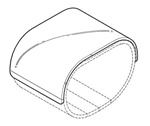The nice thing about a United States design patent, as opposed to a more common utility patent, is that it doesn't actually have to work. Hell, it doesn't even have to make sense - it just has to be a mostly-new idea that's concrete enough to put into a technical doodle. So it is with Design Patent D726,140, awarded to LG by the US Patent and Trademark Office last week. If you could turn one of those slap-bracelets from the 90s into a phone-watch hybrid, it would look a lot like this.
"FIG. 1 is a perspective view of a mobile phone showing our new design in which the display part has been bent and wound around the band"
The design patent covers a fairly standard (if impossibly thin) slate smartphone that curves backwards on the top and bottom. This allows it to be placed or docked onto a bracelet, thus turning the whole thing into an enormous smartwatch, or perhaps a "smart cuff" as this particular style has lately been called. Exactly how the phone is secured to the band isn't made clear, though a locking tab or a particularly strong magnet might make sense.
LG digs the flexible curved screen design, and both the G Flex and the G Flex 2 feature both OLED screens and bodies that curve and bend. Contrast that to designs from Samsung like the Galaxy S6 Edge, which have more dramatic bends in the screen itself but a body that's entirely rigid.
That said, this particular concept seems to be well beyond the limits of consumer technology at the moment. (We mocked something similar for the same reason, and also for asking for your money.) Components like the primary system-on-a-chip, the battery, and the casing would have to be just as flexible as the screen and capable of standing up to thousands of repetitive bends. Right now we haven't seen anything close to production designs from OEMs that would fill that need, so the idea is several years away at least. LG applied for this patent in January of last year.
But again, that's the (sort of) nice thing about design patents. You don't have to make it work - you don't even have to make it - you just have to dream it up.
A note for tech sites covering our report: the diagrams contained in this post have been published by the United States Patent and Trademark Office in Design Patent D726,140, awarded to Sangmin Park, Seunghoon Ryu, and Jonghak Lee, and assigned to LG Electronics Inc. They are free for anyone to access and cite. Feel free to copy as many images from this article as you would like. A source link back to this article would be nice, but we're not going to lose sleep if you leave it out. Thank you for your cooperation.
Source: US Patent and Trademark Office

